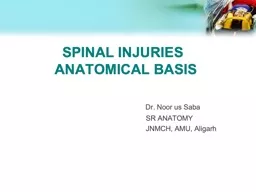/


Anatomical basis Dr Noor us Saba ID: 1000270
Download Presentation The PPT/PDF document "SPINAL INJURIES" is the property of its rightful owner. Permission is granted to download and print the materials on this web site for personal, non-commercial use only, and to display it on your personal computer provided you do not modify the materials and that you retain all copyright notices contained in the materials. By downloading content from our website, you accept the terms of this agreement.
1. SPINAL INJURIES Anatomical basis Dr. Noor us Saba SR ANATOMY JNMCH, AMU, Aligarh
2. Definition Insult to spinal cord resulting in a change, in the normal motor, sensory or autonomic function. This change is either temporary or permanent.
3. Statistics:Causes of spinal injury Major Vehicle Accidents, Falls, SportsGunshot Injuries, Blunt Assault, Diving Accidents Stab Wounds 55% cases occur in 16 – 30yrs of age81.6% are male!
4. Anatomy of Spinal CordSpinal cord:Extends from medulla oblongata – L1 Lower part tapered to form conus medullaris
5.
6.
7. Myotomes : Segmental nerve root innervating a muscleAgain important in determining level of injuryUpper limbs: C5 - Deltoid C 6 - Elbow flexors C 7 - Elbow extensors C 8 - Long finger flexors T 1 - Small hand muscles
8. Lower Limbs : L2 - Hip flexors L3,4 - Knee extensors L4,5 – S1 - Knee flexion L5 - Ankle dorsiflexion S1 - Ankle plantar flexion
9. What is and how do you determine the level of injury?Motor level = the last level with at least 3/5 (against gravity) functionNB: this is the most important for clinical purposesSensory level = the last level with preserved sensationRadiographic level = the level of fracture on plain XRays / CT scan / MRINB: spine level does not correspond to spinal cord level below the cervical region
10. Cord level C2 – C7 = add +1 for cord level T1 – T6 = add +2 T7 – T9 = add +3T10 = L1, L2 levelT11 = L3, L4 levelL1 = sacro coccygeal segments
11. Direct traumaCompression by bone fragments / haematoma / disc material Ischemia from damage / impingement on the spinal arteriesMechanisms of Spinal Cord Injury
12. Mechanisms of Vertebral Collumn InjuriesExtremes of motionHyperextensionHyperflexion: “Kiss the Chest”Excessive RotationLateral bendingAxial StressAxial loadingCompression common between T12 and L1DistractionCombinationDistraction/Rotation or compression/flexionOther ModesDirect, Blunt or Penetrating traumaElectrocution
13. Flexion Injury
14. Compression injury
15. Hyperextension Injury
16. Distraction Injury
17. Thoracic & Lumbar Fracture
18. Seat Belt Fracture
19. Seat Belt Fracture(Chance Fracture): Thoraco-lumbar regionCause: Flexion Distraction injury
20. Spinal Cord Injury ClassificationQuadriplegia : injury in cervical region all 4 extremities affectedParaplegia : injury in thoracic segments both lower extremities affected
21. Injury either:Complete Incomplete
22. Complete: “Complete” = absence of sensory and motor function in the perianal area (S4-S5) Loss of voluntary movement of parts innervated by segment, this is irreversibleLoss of sensation
23. Incomplete: Some function is present below site of injuryMore favourable prognosis overallAre recognisable patterns of injury, although they are rarely pure and variations occur
24. Goal of spine trauma careProtect further injury during evaluation and managementIdentify spine injury or document absence of spine injuryOptimize conditions for maximal neurologic recovery
25. Goal of spine trauma careMaintain or restore spinal alignmentMinimize loss of spinal mobilityObtain healed & stable spineFacilitate rehabilitation
26. Pre-hospital management Protect spine at all times during the management of patients with multiple injuries Up to 15% of spinal injuries have a second (possibly non adjacent) fracture elsewhere in the spine Ideally, whole spine should be immobilized in neutral position on a firm surface
27. Pre-hospital management Cervical spine immobilizationTransportation of spinal cord-injured patients
28. Transportation of spinal cord-injured patientsEmergency Medical Systems (EMS)Paramedical staffPrimary trauma centerSpinal injury center
29. Cervical Spine Imaging OptionsPlain filmsAP, lateral and open mouth view Optional: Oblique and Swimmer’s CTBetter for occult fracturesMRIVery good for spinal cord, soft tissue and ligamentous injuriesFlexion-Extension Plain Filmsto determine instability
30. Alignment The anterior vertebral line, posterior vertebral line, and spinolaminar line should have a smooth curve with no steps or discontinuities Malalignment of the posterior vertebral bodies is more significant than that anteriorly, which may be due to rotation A step-off of >3.5mm issignificant anywhere
31. Lateral Cervical Spine X-RayAnterior subluxation of one vertebra on another indicates facet dislocation< 50% of the width of a vertebral body unilateral facet dislocation> 50% bilateral facet dislocation
32. DiscDisc SpacesShould be uniform Assess spaces between the spinous processes
33. Soft tissueNasopharyngeal space (C1)10 mm (adult)Retropharyngeal space (C2-C4)5-7 mmRetrotracheal space (C5-C7) 14 mm (children)22 mm (adults)
34. CT ScanThin cut CT scan should be used to evaluate abnormal, suspicious or poorly visualized areas on plain filmThe combination of plain film and directed CT scan provides a false negative rate of less than 0.1%
35. MRIIdeally all patients with abnormal neurological examination should be evaluated with MRI scan
36. Thank you